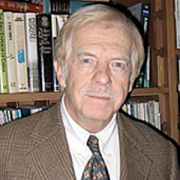When I was a bright-eyed and bushy-tailed youngster in a small town in the U.S. Midwest, there was little to suggest that I might become interested in psychiatry, and certainly very little to predict an interest in cultural and ethnic issues. My relatives were mainly farm people, but my father had become a chemist and his work for Mobil Oil Co. introduced our family to some interesting experiences during my teenage years.
I ventured off to the University of Kansas, and while a history major, got interested in medicine and ventured further into the world by going to the University of Kansas School of Medicine in Kansas City. With the Vietnam situation getting more tense, after graduation in 1966 I decided to intern in the U.S. Public Health Service to give me access to medical positions in the Indian Health Service after internship, to avoid being drafted to serve as a military doctor in the Vietnam war. But, at the end of my internship, I found that I could satisfy my military obligation by serving as a physician in the American Peace Corps, so I applied and was selected. I had gotten married to my wife Janet just after medical school, and she was an enthusiastic partner in this Peace Corps venture and we sallied forth to Washington, D.C. for training.
We got assigned to work in Nepal, me the Peace Corps doctor and Jan working first as a volunteer in a leprosy clinic and later an elementary teacher in the International School in Kathmandu. I enjoyed my first “real doctor” experience for the young Peace Corps volunteers. I delighted in trekking around the hills of Nepal to visit them, give them gamma globulin injections to protect against hepatitis, and to get to know something about the different tribal peoples of both the Nepalese hills and the plains of the upper Ganges river. I got my first taste of being a physician who could take the time to talk to my patients and get to really know them as people. Jan and I also had a chance to take off on a 3 week trip through Asia in 1968 and visit India, Thailand, Malaysia, Hong Kong and Cambodia. This whetted my appetite to learn more about the world, preferably working as a doctor along the way. Our first daughter was born in a missionary hospital in Kathmandu at the end of our Nepal assignment.
After finishing Peace Corps, I returned to Portland, Oregon to begin an Internal Medicine residency but quickly realized I was more suited to psychiatry and the more personal relationship you can have with your patient. We moved to Seattle and I began my residency in psychiatry at the University of Washington Medical School. I followed the Community Psychiatry/Transcultural track and as a Senior Resident was able to do some research on American Indian alcoholism with Jim Shore who was at the University of Oregon. After finishing residency training, I joined the faculty at U.W. and began in the clinician/teacher/scholar pathway, but always found a way, on inpatient services or Consultation/Liaison (C/L) services to integrate teaching about cultural and ethnic factors into day-to-day practical clinical problem solving. Luckily, Arthur Kleinman came to my department in the mid-70s and I was able to attend his multidisciplinary seminars for anthropologists and mental health professionals.
In 1976, I took a leave of absence from the U.W. to become Chief of Mental Health Services for the Trust Territory of the Pacific Islands (Micronesia), living in Saipan in the far Western Pacific. This was intriguing work and took me all over the islands of the “American Pacific” such as Truk, Yap, Palau, the Marshall Islands and others. I became fascinated with the variety of the Pacific island peoples. I did clinical work and teaching, but also saw the need for good psychiatric consultation to the legal system in developing and remote areas. Data that I collected during 1976-78 became the basis for a number of papers written about interesting clinical and cultural challenges of practicing and teaching psychiatry in that huge and remote area of the globe. 1978 to 1983 were years of continuing faculty involvement in traditional ways at U.W., with research collaboration and writing papers. A chance for a sabbatical year arose in 1983, and our family went to New Zealand where I was visiting faculty at the Christchurch Clinical School of Medicine in Christchurch, on the South Island. (My luck again: Ron Wintrob had suggested Christchurch as a welcoming and invigorating place for an academic sabbatical.) I worked with many bright “Kiwi” clinician- researchers, taught the registrars on the C/L service of a public teaching hospital, and learned about the health problems of the Maori people. I also observed up close New Zealand’s fine health care system.
The second half of that sabbatical year was in The People’s Republic of China doing research for two months at the Hunan Medical College (now Central South University) in Changsha, Hunan province. An esteemed Chinese academic, Prof. Derson Young, had been in Seattle at the U.W. as one of the first Chinese psychiatrists allowed to come to the West to study in the early 80s. After our connection in Seattle, Prof. Young became my colleague in China for my research on the differences in symptoms between psychotic patients in China and the U.S. After two months in Hunan, our family traveled widely in China and returned for a visit to Nepal to show our daughters the locale of our early married life and Peace Corps work.
After return to Seattle in 1984, I resumed the active faculty life, assuming the directorship of a very busy C/L service at U.W.’s busiest teaching hospital. In addition to the clinical and teaching demands of that position, I was asked by the W.H.O. to visit some Pacific and Asian areas as a “Short-term Mental Health Consultant”. Over the next several years I consulted in Fiji, Tonga, Cambodia and twice in Saipan. These assignments presented the same challenge I had faced in Micronesia in the late 70s: How do less developed countries bring quality mental health care to populations (sometimes very small) in widely dispersed areas with very meager resources? Later, I was asked to visit the Fiji School of Medicine in Suva and help develop a curriculum in behavioral sciences.
From 1984 to 2004, the C/L service and its demands back at my University of Washington department continued to engage me for most days and months. Although suicide attempts, delirium in post surgical and medical patients, and depression across the life span was the everyday bread and butter of C/L work, there was enough multicultural variety in Seattle to keep things very interesting. It was my conviction that on a daily basis, a cultural or ethnic feature of a case probably would add a challenging and sometimes exotic teaching dimension to what on the surface was a mundane or “everyday” clinical situation.
In the last several years, I have been able to take time off from faculty work to do temporary teaching at medical schools in the developing world. In 2005, I went back to the Fiji School of Medicine for two months of work with 5th and 6th year medical students in their psychiatry rotations. Since mid-2006, I have been part-time in my work in Seattle and able to think about more overseas travel and projects. In January 2007, I went for two weeks to the University of Phnom Penh Medical School in Cambodia at the invitation of the Dean who I had gotten to know when he had done post-doctoral studies in Seattle. This time, work was within the school’s psychiatry curriculum for psychiatry residents and some graduate psychiatrists, with the topics ones they had chosen. Eager students and receptive doctors made the visit another wonderful experience of international transcultural psychiatry teaching, with learning decidedly going in both directions.
I have been extremely fortunate to have had contact with some of the people who have shaped Cultural Psychiatry over the past thirty years. H.B.M. Murphy, Arthur Kleinman, Jim Boehnlein, Ron Wintrob, Dave Kinzie and many others have contributed much to our field with their creative minds and devoted scholarship. I have benefited by going to annual Society for the Study of Psychiatry and Culture meetings (as well as others) and hearing the brilliant theoretical minds of such people as Laurence Kirmayer and reading his papers and analyses in “Transcultural Psychiatry”. My contributions to this field have certainly been commonplace. Yet, cultural psychiatry and international psychiatry need the practical and the applied as well as the theoretical and the abstract. Our field has room for all kinds of investigators and clinician/teachers. I have been lucky to have found a niche in this area and to have grown professionally by hearing and reading the work of the broad group of scholar-clinicians that our field has produced over these past few decades.
July 5, 2007

